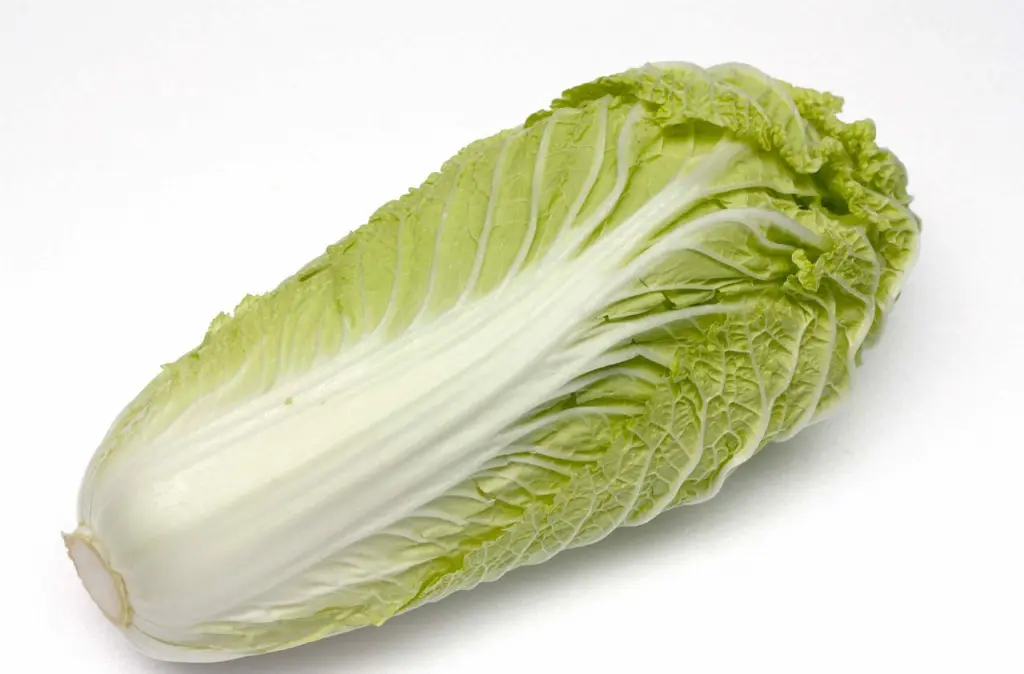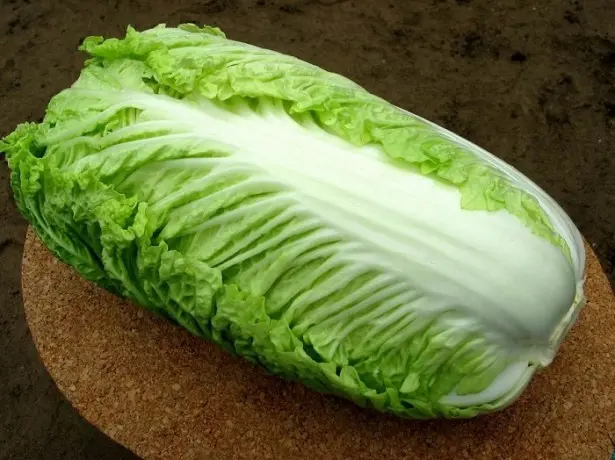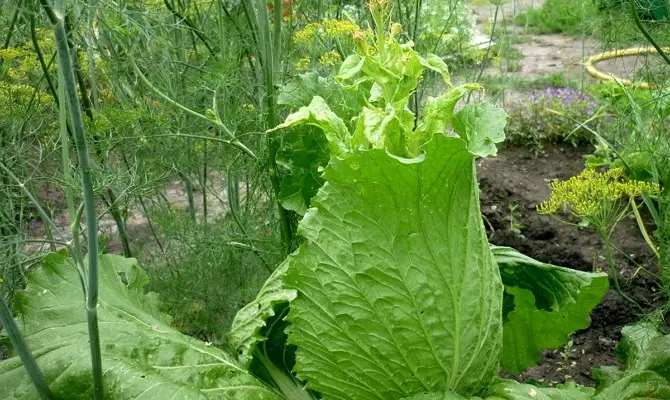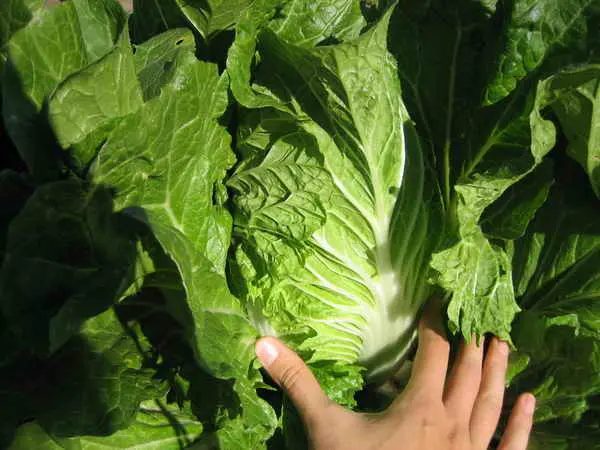Contents
Cabbage is different. This tasty and healthy vegetable has an important place in the daily diet. Today we will talk about Beijing cabbage, its cultivation technology, care and pest control. By the name, you can understand that China is the birthplace of this crop, but it can be grown quite successfully in our country. Most gardeners will appreciate the unpretentiousness and fertility of the plant. Beijing cabbage is an excellent choice for home gardens and greenhouses.
seedless way
Sowing seeds for a permanent place of growth is convenient and, in the case of Beijing cabbage, correctly. The seedless method of planting has proven to be more productive, since the seedlings of this crop do not always take root well in a new place, even with sufficient care. Most often, seeds are sown in a ribbon-line method. The distance between the tapes must be at least 50 centimeters.
 You can also plant seed material in several pieces in the holes, which are pulled out at a distance of 35-40 centimeters. In each of these cases, further care involves thinning. You need to leave the tallest plants. The sowing depth is 1-2 centimeters. If you use a greenhouse for growing, then no additional protective measures need to be taken. In open ground conditions, it does not hurt to cover crops with plastic wrap to create a greenhouse effect. Depending on the weather, the first shoots will appear in 4-10 days.
You can also plant seed material in several pieces in the holes, which are pulled out at a distance of 35-40 centimeters. In each of these cases, further care involves thinning. You need to leave the tallest plants. The sowing depth is 1-2 centimeters. If you use a greenhouse for growing, then no additional protective measures need to be taken. In open ground conditions, it does not hurt to cover crops with plastic wrap to create a greenhouse effect. Depending on the weather, the first shoots will appear in 4-10 days.
seedling
The seedling method of growing Beijing is more laborious, but this is the method that is preferred for residents of the northern regions or if you want to get an earlier harvest. Seeds for seedlings are sown around the end of March. Individual peat pots or peat tablets are best suited for this mission. The culture reacts poorly to picking and is hard to transplant.

For growing seedlings, it is best to prepare light and loose soil from humus and coconut substrate. Seeds are planted to a depth of no more than 1 centimeter. After moistening the landing, it is cleaned in a dark and warm place. The first shoots, as a rule, appear after 3-4 days. After the leaves appear, the pots are taken out into the light. Seedling care includes moderate watering. Before planting, seedlings can not be watered for 3-4 days. Plants should be transferred to open ground or an unheated greenhouse when they have 4-5 leaves.
Terms of planting
How good a crop you get depends on the time of planting seeds or seedlings. It is best to sow Beijing cabbage from April 15 to 20 and from July 20 to August 10. In warm regions, cultivation can be started from the end of March. The main thing is to be sure that the night frosts have departed. The interval between April 20 and July 20 is considered unfavorable for planting this crop, since due to the long daylight hours there is a problem of flowering and arrows.

With the right planting technology and sufficient care, the crop can be harvested in about 45-50 days. Beijing cabbage is quite cold-resistant. Seeds can germinate even at +4°C. Although active growth is observed at stable + 15- + 20 ° С. When growing a vegetable in a greenhouse, it is important to take into account such a temperature regime. With lower or excessively high readings on the thermometer, it is not necessary to wait for good harvests.
Video “We grow Chinese cabbage”
Care
There are 3 main components of care that contribute to the growth of cabbage – moisture, light and coolness. At the same time, it is important to understand that only adult plants can survive frosts, but for young seedlings, drastic drops in temperature are detrimental. If you live in the northern regions, it is better to plan sowing in August, and use a greenhouse for spring planting.
During cultivation, it is useful to use covering fabric materials. With their help, you can protect the beds from excessive sunlight and pests. After 12-15 days after planting, it is necessary to mulch the ridges. The technology of covering the soil with sawdust or straw prevents premature loss of moisture and slows down the growth of weeds. Mulching is recommended both in open ground conditions and in greenhouses.

Watering should be moderate, on average 1 time per week. Make sure that excess water does not stagnate on the site, otherwise the roots may begin to rot. During the cultivation of Beijing cabbage, it is necessary to carry out top dressing. After germination or 2 weeks after planting seedlings, the culture is treated with a solution of mullein (1:10) or chicken manure (1:20). Before sowing, you can treat the soil with urea and superphosphate. Care should also include
Pest Control
Juicy and fresh Peking leaves are liked not only by us, but also by all kinds of small garden pests. The first place in danger is occupied by cruciferous fleas and slugs. It is almost impossible to fight these parasites if they have already reached the vegetable. At a fast breeding rate, they destroy cabbage after cabbage, leaving only perforated leaves.
Therefore, experienced specialists recommend acting on a warning and including special planting treatments and the manufacture of shelters in comprehensive care.
First of all, it is necessary to prevent possible contact of fleas with cabbage. The easiest way is to hide the plants in the greenhouse. It is much easier to control the appearance of any living creatures and you can quickly remove insects. If you don’t have a greenhouse and Beijing cabbage is grown in open ground conditions, cover the beds with a non-woven fabric. Such a simple technology will allow you to take uninvited guests aside.

In order for the Pekinka to get stronger and grow without flea attacks, observe the planting dates. It is best to plan sowing in early spring or late summer. Then in the first case there will be no insects yet, and in the second case there will be no more. Good results are obtained by dusting the beds with wood ash immediately after planting. Also consider the predecessors of cabbage in a row. If in the previous season cruciferous plants (radishes, mustard, cabbage) grew in this area, it is likely that dozens of pupae are waiting in the ground.
You can also try to fool the flea by planting Chinese cabbage mixed with tomatoes, potatoes, garlic or onions. You can only fight existing fleas with professional tools such as Aktara, Actellik, Inta-Vira. Spraying with these preparations is carried out no later than 1 month before harvesting. Garden slugs love this vegetable no less than fleas. They appear on rainy and cloudy days, so if the season turned out to be wet, then you need to carefully monitor the landing.
Slugs are used to hiding in dark and damp places. In order to collect these pests in one place, you can spread wooden boards or burdock leaves between rows. Slugs will definitely take advantage of the proposed conditions, and then you will only have to manually harvest the “harvest” of pests. Also, slugs can be repelled with the help of special treatment. Mix a half-liter jar of wood ash with 1 tablespoon of dry mustard, 2 tablespoons of salt, and 2 tablespoons of hot ground pepper. Sprinkle the mixture on the beds and aisles.
Video “Beijing cabbage”
Everything you wanted to know about this culture, you will find in the following video.









